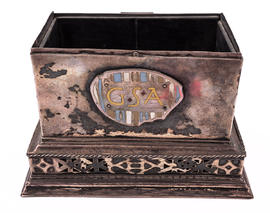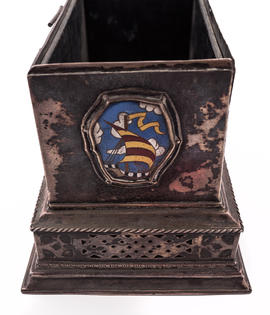Key Information
Reference code
Title
Date(s)
- c1915 (Creation)
Level of description
Item
Extent
1 item
Content and Structure
Scope and content
Oblong metal box on fretwork pedestal with four decorative enamel plaques, two ships on the shorter sides, GSA letters and a list of makers on the longer sides. Remains of hinge and catch suggest missing lid. Makers were: J C Kant; G G Killin; M E Robley; I T Smith; E Wilson.
Appraisal, destruction and scheduling
Accruals
System of arrangement
General Information
Name of creator
Biographical history
Janet Charles Kant (born on the 27th of March 1884) studied at The Glasgow School of Art from 1900 to 1922. One of her parents (unspecified) worked as a Design Copyist, a role which, during the turn of the century, was often occupied by women as it did not entail original drafting or design which were professions “not considered advisable” for women.At the age of sixteen, Kant enrolled at the School as a Drawing & Painting student, and during her subsequent studies was taught by Paul Artot and Maurice Griffenhagen. After taking a year out during the 1912-13 academic year, she returned to the School to study for a further nine years, re-focusing on design and specifically metalwork, studying etching with Susan F. Crawford. In The Dictionary of Scottish Art and Architecture, Kant is described as a ‘painter and engraver’, reflective of her two periods of study at the School. Whilst studying between the years 1914 and 1917, she exhibited at the Royal Scottish Academy of Arts and at the Royal Glasgow Institute of the Fine Arts, including a Roll of Honour for those serving in World War One. Kant’s work is included in ‘Arts & Crafts: A Review of the Work Executed by Students in the Leading Art Schools of Great Britain and Ireland’ by Charles Holme (1916), which lists a ‘casket in silver and enamel’ made by her. If you have any further information please get in touch.
Name of creator
Biographical history
Georgina Goldie Killin (born on the 30th of January 1884, Lanarkshire) studied at The Glasgow School of Art from 1913 to 1921, staying on as a teacher from 1922 to 1929. She studied design (with a year of drawing and painting from 1917 to 1918), and was taught at least in part by Ann Macbeth, a notable Glasgow Girl and prominent suffragette, who was a staff member at GSA from 1902 to 1929. Macbeth is perhaps best known for her contributions to embroidery, but also taught metalwork, bookbinding and (from 1912) ceramic decoration. Killin is recorded as being taught by Macbeth in her first year 1913/14, and again in 1917/18 when she studied metalwork. During her teaching career at The Glasgow School of Art, Killin was involved in a number of aspects of design education. She began by teaching ceramics making and decoration (from 1922-23), followed by assisting with lectures on Design and Decorative Art (1923-25), and assisting Design and Museum Study (1925-28), before finally going on to teach Historic Ornament and Heraldry, and Enamels (both 1928-29). More recently Alison Brown, curator of European Decorative Art at Glasgow Museum, has been researching Killin’s ceramic work in more detail, using material from the GSA Archives to bring more of her work to light. If you have any more information, please get in touch.
Name of creator
Biographical history
Marjorie Elizabeth Robley was born in 1894 and resided at Thirlestane, Helensburgh, during her time as a student of The Glasgow School of Art. Her tuition was subsidised by Dumbarton Local Authority throughout this period. Robley had a lengthy academic career at The School, attending for a total of seven years between 1914 and 1922. There is a break in her education for the academic year commencing 1918, although the reasons for this are unknown. Robley attended as a day student throughout her time at The School. She initially enrolled as a student of Drawing and Painting, however she switched focus to Design after one year. Robley specialised in Metal Work, which likely included repoussé and gold and silversmith work. Robley was under the tutelage of P. Wylie Davidson, the instructor for Design and Decorative Arts at this time. Whether Marjorie Robley continued her artistic ambitions after her studies is unknown. If you have any further information, please get in touch.
Name of creator
Biographical history
Presumed to be a student (probably female) at the GSoA in c1905, as named as one of the makers of a metal box along with J C Kant, G G Killin, M E Robley and E Wilson.
Name of creator
Biographical history
This may be Elizabeth "Cissie" Wilson was born in 1893. She studied design, drawing and painting, and fashion plate at The Glasgow School of Art from 1912 to 1916. She served as a Voluntary Aid Detachment from September 1915 to March 1919, serving as a nurse at the No 11 General Hospital in France, 2nd Western General Hospital in Manchester, and No 57 Military Hospital in France. Wilson was awarded the 1914-1915 Star campaign medal for her work with the British Red Cross. She also received 1 Scarlet Efficiency Stripe on June 3rd 1919 for her service, and is listed in the School's World War One Roll of Honour.
However, it could also be Elizabeth S Wilson who was born on 5th May 1893. She was a day student at The Glasgow School of Art from 1914 to 1918, studying Drawing and Painting, Life Drawing, Costume Design, and Metalwork. She was one of three recipients of a £10 bursary from the Robert Hart Trust for the session 1914/15. During her entire time at the School she stayed at Elgin Terrace in Glasgow.
If you have any more information, please get in touch.
Archival history
Custodial history
Physical Description and Conditions of Use
Conditions governing access
Conditions governing reproduction
Language of material
Script of material
Language and script notes
Physical Description
Dimensions: 135 x 130 x 195 mm
Finding aids
Related Material
Existence and location of originals
Existence and location of copies
Related materials
Notes area
Alternative identifier(s)
Keywords/Tags
Subjects
Place access points
People and Organisations
- The Glasgow School of Art (Subject)







